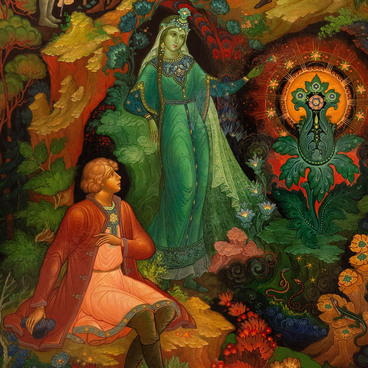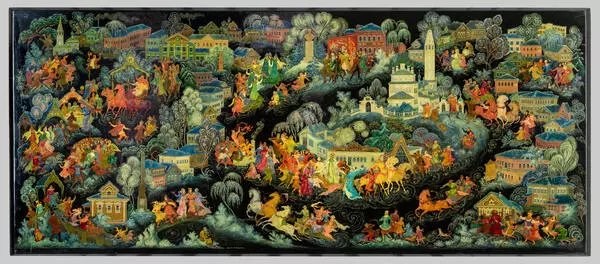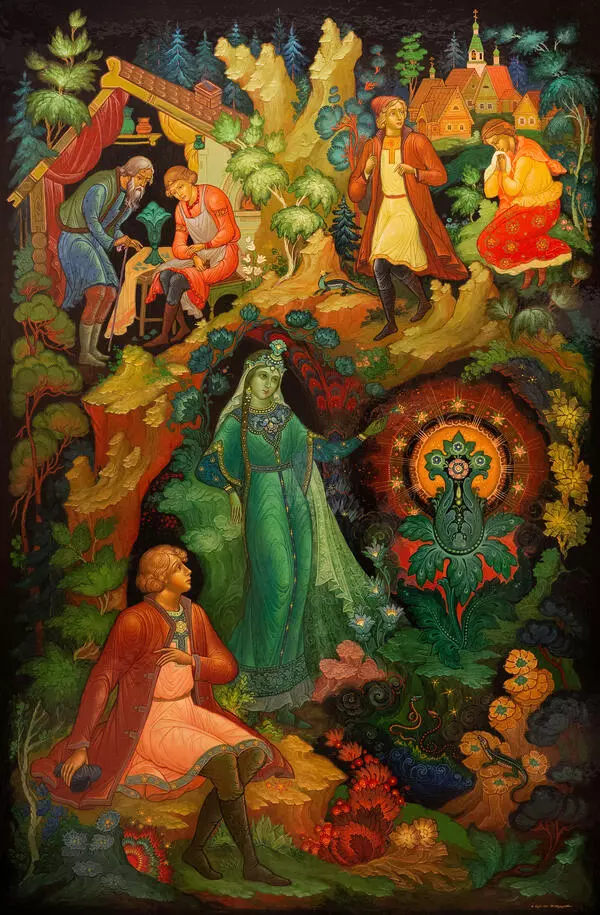Kaleria Kukulieva, artist of the creative workshop “Paleshane”, created the panel “The Mistress of the Copper Mountain” in 1999. It forms a diptych with another work by the same author — “The Mountain Craftsman”. Both works are based on the fairy tales of Pavel Bazhov, they have common heroes: the Mistress of the Copper Mountain herself, master Danila and his bride Katya.
In the fairy tale “The Stone Flower”, orphan Danila became a disciple of an old man Prokopich. The basics of stone art were easy for him; soon the young carver began to fulfill complex orders. One of the old masters told him about a stone flower that grows in the domains of the Mistress of the Copper Mountain. Since then, Danila decided to create the same flower with his own hands. However, he did not succeed, and then he asked the mistress to become her mountain master.
In the fairy tale “The Mountain Craftsman” (also translated as “The Mountain Master”), Danila was believed to be dead by everyone except his fiancée Katya. She first decided to wait for him, and then went to the Copper Mountain to rescue him.
In his works, Pavel Bazhov described the bowl that Danila carved from a single piece of malachite. In reality, this could not have happened. In the Copper Mountain — the Gumeshevsky mine — large blocks were never found, so only small items were cut out of solid stone. The Russian mosaic technique was used for large-scale works: the base of another material was covered with thin plates of malachite.
The panel “The mistress of the Copper Mountain”, like other works in the Palekh miniature painting technique, depicts several scenes. In the upper part, the artist painted master Danila inside the mountain next to the stone flower, and Katya, who went looking for him. The scene at the bottom of the canvas corresponds to the climax of the tale: Katya met with the Mistress of the Copper Mountain, and she agreed to let her fiancé go back to his people.
The prototype of craftsman Danila in Bazhov’s fairy tales was a real person — Danila Zverev. He was not a stonecutter, but he served as a mountain master, a specialist in the extraction of precious and ornamental stones. Zverev selected the materials for the famous “Mosaic Map of France, 1900”, the stars of Moscow Kremlin, the stone mosaic “Map of Industrialization” of the USSR.
In the fairy tale “The Stone Flower”, orphan Danila became a disciple of an old man Prokopich. The basics of stone art were easy for him; soon the young carver began to fulfill complex orders. One of the old masters told him about a stone flower that grows in the domains of the Mistress of the Copper Mountain. Since then, Danila decided to create the same flower with his own hands. However, he did not succeed, and then he asked the mistress to become her mountain master.
In the fairy tale “The Mountain Craftsman” (also translated as “The Mountain Master”), Danila was believed to be dead by everyone except his fiancée Katya. She first decided to wait for him, and then went to the Copper Mountain to rescue him.
In his works, Pavel Bazhov described the bowl that Danila carved from a single piece of malachite. In reality, this could not have happened. In the Copper Mountain — the Gumeshevsky mine — large blocks were never found, so only small items were cut out of solid stone. The Russian mosaic technique was used for large-scale works: the base of another material was covered with thin plates of malachite.
The panel “The mistress of the Copper Mountain”, like other works in the Palekh miniature painting technique, depicts several scenes. In the upper part, the artist painted master Danila inside the mountain next to the stone flower, and Katya, who went looking for him. The scene at the bottom of the canvas corresponds to the climax of the tale: Katya met with the Mistress of the Copper Mountain, and she agreed to let her fiancé go back to his people.
The prototype of craftsman Danila in Bazhov’s fairy tales was a real person — Danila Zverev. He was not a stonecutter, but he served as a mountain master, a specialist in the extraction of precious and ornamental stones. Zverev selected the materials for the famous “Mosaic Map of France, 1900”, the stars of Moscow Kremlin, the stone mosaic “Map of Industrialization” of the USSR.





